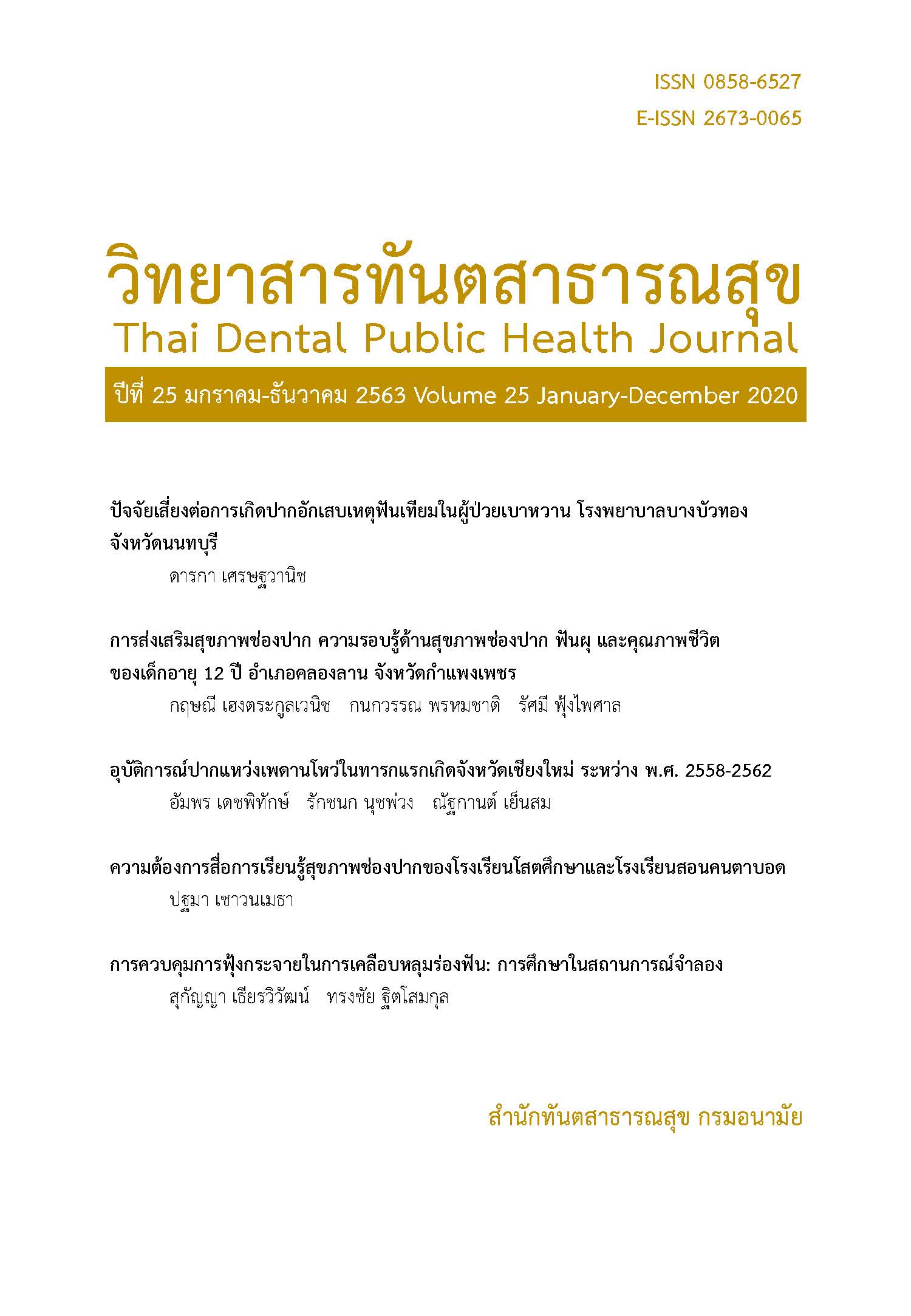Spreading control on dental sealant procedure: a simulation study
Main Article Content
Abstract
During corona virus 2019 outbreak, dental services including dental sealing had been postponed because of contaminated fluids, saliva, or aerosols spread causing potential risk on viral transmission. This experiment using a phantom head intended to investigate the spread of pumice and aerosol during 3 steps of tooth preparing for the pit-fissure sealing which were tooth-polishing with a low-speed handpiece, water-rinsing and air-drying. Reflective paint was mixed in pumice polishing paste for clearly observation when spreading. Mixture of artificial saliva and reflective paint was injected into the mouth to simulate salivary flow. The level of pumice and aerosol spreads were observed and the efficiency among 3 types of saliva evacuation which were high power suction (HPS) having dental assistant, low power suction with saliva ejector (SE) having dental assistant, and SS-suction (SS) having no dental assistant were compared. The experiment performed during May to June 2020. The pumice spread was not found after low speed tooth-polishing. HPS and SS could evacuate saliva and control the spread more efficiently than SE. SE having lower suction speed, caused water splattering during rinsing and drying. In post covid-19 era, dental sealant can be performed with low speed tooth-polishing and using HPS. In case of lacking dental assistant, SS could be used.
Downloads
Article Details
References
WHO. WHO coronavirus disease (COVID-19) dashboard. [online] 30 October 2020 [cited 2020 October 30 ]. Available from: https:// covid19.who.int/?gclid=CjwKCAjw0On8BRAgEiwAincsHJn4iIaGd2p37sBtUqji6d6zyZxptOxjGOtBn-_JLvb6Ui_ygtebxoCkX0QAvD_BwE.
Department of Disease Control, Ministry of Public Health. Corona virus infectious disease 2019 (COVID-19): The situation in Thailand. [online] 30 October 2020 [cited 2020 October 30]. Available from: https:// ddc.moph.go.th/viralpneumonia/index.php.
Government Information Service Center for People Project. Preparation for the re-opening of establishment under situation of COVID-19. [online] 29 April 2020 [cited 2020 July 15]. Available from: http://www.gcc.go.th/ webgcc/?p=9795.
Abramovitz I, Palmon A, Levy D, Karabucak B, Kot-Limon N, Shay B, et al. Dental care during the coronavirus disease 2019 (COVID-19) outbreak: operatory considerations and clinical aspects. Quintessence Int. 2020; 51(5): 418-29. doi:10.3290/j.qi.a44392.
Gugnani N, Gugnani S. Safety protocols for dental practices in the COVID-19 era. Evid Based Dent. 2020; 21(2): 56-7. doi:10.1038/ s41432-020-0094-6.
Naqvi K, Mubeen SM, Ali Shah SM. Challenges in providing oral and dental health services in COVID-19 pandemic. J Pak Med Assoc. 2020; 70(Suppl 3)(5): S113-s7. doi:10.5455/jpma.26.
Zemouri C, de Soet H, Crielaard W, Laheij A. A scoping review on bio-aerosols in healthcare and the dental environment. PLoS One. 2017; 12(5): e0178007. doi:10.13 71/journal.pone.0178007.
Izzetti R, Nisi M, Gabriele M, Graziani F. COVID-19 transmission in dental practice: brief review of preventive measures in Italy. J Dent Res. 2020: 22034520920580. doi:10.1177/0022034520920580.
Peng X, Xu X, Li Y, Cheng L, Zhou X, Ren B. Transmission routes of 2019-nCoV and controls in dental practice. Int J Oral Sci. 2020; 12(1): 9. doi:10.1038/s41368-020-0075-9.
Richards W. Being a dentist in the pandemic. Evid Based Dent. 2020; 21(2): 58-9. doi:10.1038/s41432-020-0095-5.
Department of Disease Control, Ministry of Public Health. Checklist for health facilities on COVID-19 response. [online] 1 April 2020 [cited 2020 July 4]. Available from: https:// ddc.moph.go.th/viralpneumonia/g_health_care.php.
Ampornaramveth R. Air quality in dental clinic. J Dent Assoc Thai. 2017; 1: 1-14.
Sun J, Xu Y, Qu Q, Luo W. Knowledge of and attitudes toward COVID-19 among parents of child dental patients during the outbreak. Braz Oral Res. 2020; 34: e066. doi:10.1590/1807-3107BOR-2020.vol34.00 66.
Narayana TV, Mohanty L, Sreenath G, Vidhyadhari P. Role of preprocedural rinse and high volume evacuator in reducing bacterial contamination in bioaerosols. J Oral Maxillofac Pathol. 2016; 20(1): 59-65. doi:10.4103/0973-029X.180931.
Ge ZY, Yang LM, Xia JJ, Fu XH, Zhang YZ. Possible aerosol transmission of COVID-19 and special precautions in dentistry. J Zhejiang Univ Sci B. 2020; 21(5): 361-8. doi:10.1631/jzus.B2010010.
Devker NR, Mohitey J, Vibhute A, Chouhan VS, Chavan P, Malagi S, et al. A study to evaluate and compare the efficacy of preprocedural mouthrinsing and high volume evacuator attachment alone and in combination in reducing the amount of viable aerosols produced during ultrasonic scaling procedure. J Contemp Dent Pract. 2012; 13(5): 681-9. doi:10.5005/jp-journals-10024-1209.
Harrel SK, Barnes JB, Rivera-Hidalgo F. Aerosol and splatter contamination from the operative site during ultrasonic scaling. J Am Dent Assoc. 1998; 129(9): 1241-9. doi:10.14219/jada.archive.1998.0421.
Mamoun JS. Clinical techniques of performing suctioning tasks and of positioning the high volume evacuation (HVE) attachment and inlet when assisting a dentist. A guide for dental assistants: Part 1. Dent Assist. 2011;80(5): 38-40, 2-4, 6.
Holloman JL, Mauriello SM, Pimenta L, Arnold RR. Comparison of suction device with saliva ejector for aerosol and spatter
reduction during ultrasonic scaling. J Am Dent Assoc. 2015; 146(1): 27-33. doi:10.101 6/j.adaj.2014.10.001.
Rivera-Hidalgo F, Barnes JB, Harrel SK. Aerosol and splatter production by focused spray and standard ultrasonic inserts. J Periodontol. 1999; 70(5): 473-7. doi:10.1902/jop.1999.70.5.473.
Bizzoca ME, Campisi G, Muzio LL. Covid-19 pandemic: what changes for dentists and oral medicine experts? A narrative review and novel approaches to infection containment. Int J Environ Res Public Health. 2020; 17(11): 3793. doi:10.3390/ijer ph17113793.
Odeh ND, Babkair H, Abu-Hammad S, Borzangy S, Abu-Hammad A, Abu-Hammad O. COVID-19: present and future challenges for dental practice. Int J Environ Res Public Health. 2020; 17(9): 3151. doi:10.3390/ijerp h17093151.
Proffitt E. What will be the new normal for the dental industry? Br Dent J. 2020; 228(9): 678-80. doi:10.1038/s41415-020-1583-x.


